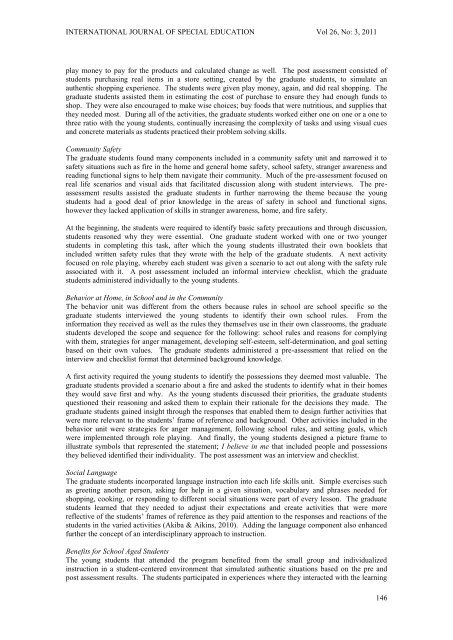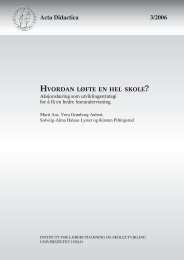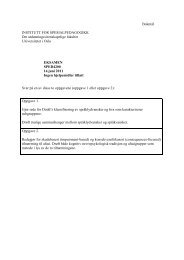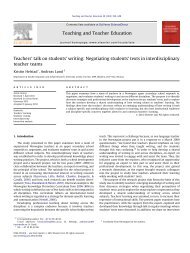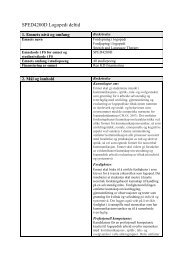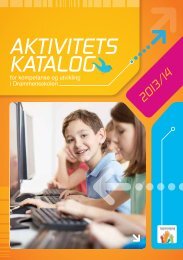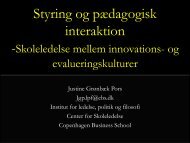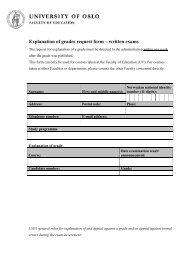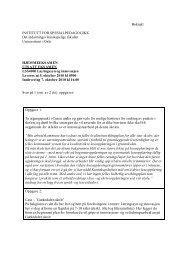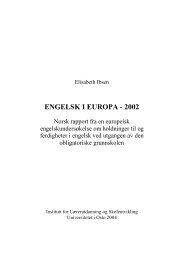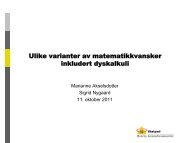International Journal Special Education
International Journal Special Education
International Journal Special Education
You also want an ePaper? Increase the reach of your titles
YUMPU automatically turns print PDFs into web optimized ePapers that Google loves.
INTERNATIONAL JOURNAL OF SPECIAL EDUCATION Vol 26, No: 3, 2011play money to pay for the products and calculated change as well. The post assessment consisted ofstudents purchasing real items in a store setting, created by the graduate students, to simulate anauthentic shopping experience. The students were given play money, again, and did real shopping. Thegraduate students assisted them in estimating the cost of purchase to ensure they had enough funds toshop. They were also encouraged to make wise choices; buy foods that were nutritious, and supplies thatthey needed most. During all of the activities, the graduate students worked either one on one or a one tothree ratio with the young students, continually increasing the complexity of tasks and using visual cuesand concrete materials as students practiced their problem solving skills.Community SafetyThe graduate students found many components included in a community safety unit and narrowed it tosafety situations such as fire in the home and general home safety, school safety, stranger awareness andreading functional signs to help them navigate their community. Much of the pre-assessment focused onreal life scenarios and visual aids that facilitated discussion along with student interviews. The preassessmentresults assisted the graduate students in further narrowing the theme because the youngstudents had a good deal of prior knowledge in the areas of safety in school and functional signs,however they lacked application of skills in stranger awareness, home, and fire safety.At the beginning, the students were required to identify basic safety precautions and through discussion,students reasoned why they were essential. One graduate student worked with one or two youngerstudents in completing this task, after which the young students illustrated their own booklets thatincluded written safety rules that they wrote with the help of the graduate students. A next activityfocused on role playing, whereby each student was given a scenario to act out along with the safety ruleassociated with it. A post assessment included an informal interview checklist, which the graduatestudents administered individually to the young students.Behavior at Home, in School and in the CommunityThe behavior unit was different from the others because rules in school are school specific so thegraduate students interviewed the young students to identify their own school rules. From theinformation they received as well as the rules they themselves use in their own classrooms, the graduatestudents developed the scope and sequence for the following: school rules and reasons for complyingwith them, strategies for anger management, developing self-esteem, self-determination, and goal settingbased on their own values. The graduate students administered a pre-assessment that relied on theinterview and checklist format that determined background knowledge.A first activity required the young students to identify the possessions they deemed most valuable. Thegraduate students provided a scenario about a fire and asked the students to identify what in their homesthey would save first and why. As the young students discussed their priorities, the graduate studentsquestioned their reasoning and asked them to explain their rationale for the decisions they made. Thegraduate students gained insight through the responses that enabled them to design further activities thatwere more relevant to the students’ frame of reference and background. Other activities included in thebehavior unit were strategies for anger management, following school rules, and setting goals, whichwere implemented through role playing. And finally, the young students designed a picture frame toillustrate symbols that represented the statement; I believe in me that included people and possessionsthey believed identified their individuality. The post assessment was an interview and checklist.Social LanguageThe graduate students incorporated language instruction into each life skills unit. Simple exercises suchas greeting another person, asking for help in a given situation, vocabulary and phrases needed forshopping, cooking, or responding to different social situations were part of every lesson. The graduatestudents learned that they needed to adjust their expectations and create activities that were morereflective of the students’ frames of reference as they paid attention to the responses and reactions of thestudents in the varied activities (Akiba & Aikins, 2010). Adding the language component also enhancedfurther the concept of an interdisciplinary approach to instruction.Benefits for School Aged StudentsThe young students that attended the program benefited from the small group and individualizedinstruction in a student-centered environment that simulated authentic situations based on the pre andpost assessment results. The students participated in experiences where they interacted with the learning146


